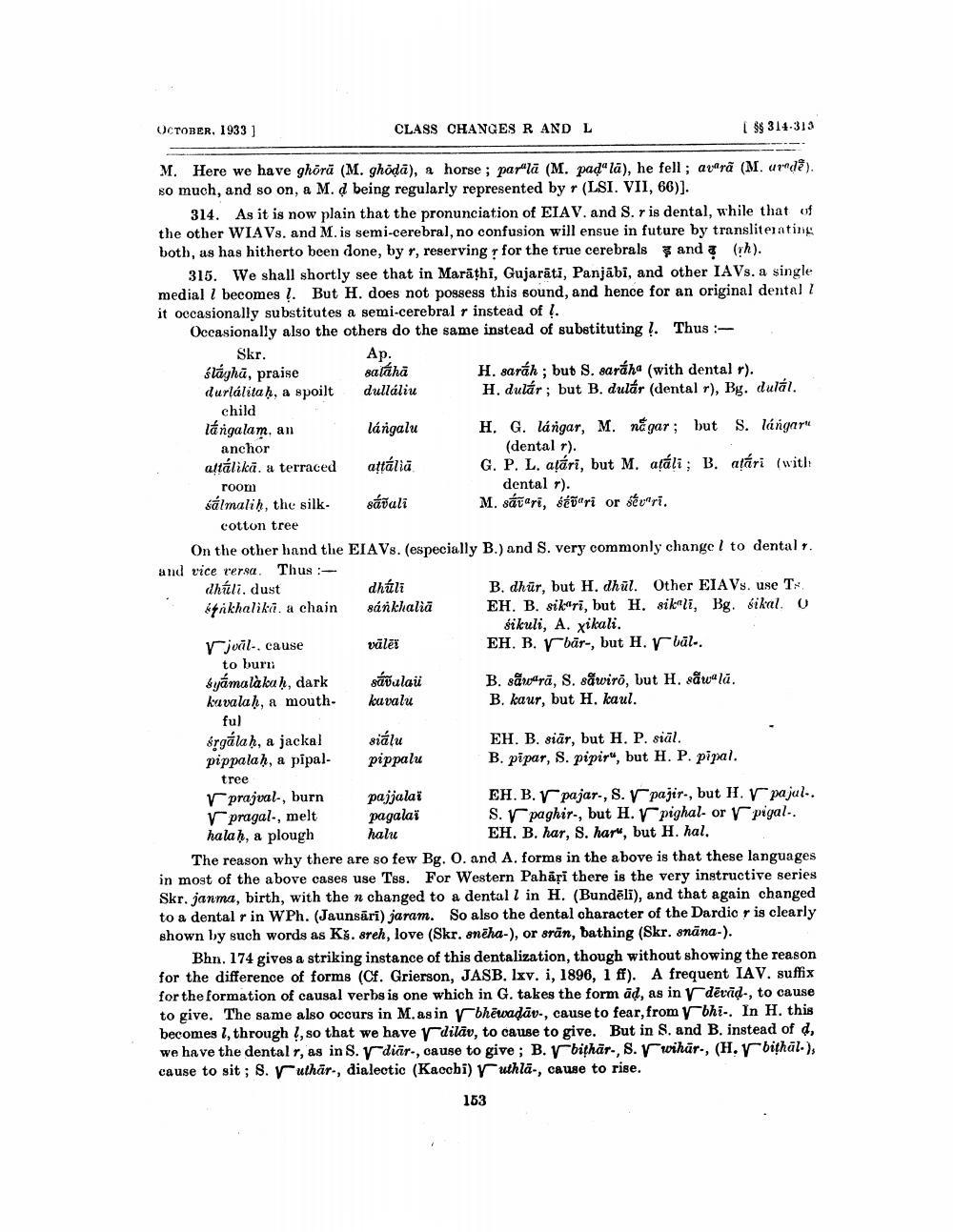________________
OCTOBER, 1933]
M. Here we have ghōrā (M. ghoḍā), a horse; parula (M. pada la), he fell; avarā (M. ured). so much, and so on, a M. d being regularly represented by r (LSI. VII, 66)].
314. As it is now plain that the pronunciation of EIAV. and S. r is dental, while that of the other WIAVs. and M. is semi-cerebral, no confusion will ensue in future by transliterating both, as has hitherto been done, by r, reserving r for the true cerebrals and (h).
Skr. ¿láka, praise durlálitaḥ, a spoilt
child.
315. We shall shortly see that in Marathi, Gujarati, Panjabi, and other IAVs. a single medial becomes . But H. does not possess this sound, and hence for an original dental it occasionally substitutes a semi-cerebral r instead of .
Occasionally also the others do the same instead of substituting. Thus :
galam, an anchor
attálikā. a terraced
room
sálmaliḥ, the silk
cotton tree
CLASS CHANGES R AND L
Vjoal-, cause to burn kamalaku, dark kavalaḥ, a mouthful
glab, a jackal pippalaḥ, a pipal
tree
Vprajval-, burn
V pragal-, melt halaḥ, a plough
Ap.
salaha dulláliu
lángalu
attália
sávali
On the other hand the EIAVs. (especially B.) and S. very commonly change to dental r. and vice versa. Thus :
dhuli, dust sakhalika. a chain
dhúli sáňkhalia
vālēt
sávalai
kuvalu
eidin
pippalu
pajjalai
pagalai
halu
[§§ 314-313
H. sarah; but S. saráha (with dental r). H. dulár; but B. dulár (dental r), Bg. dulál.
H. G. lángar, M. negar; but S. lángaru (dental r).
G. P. L. atári, but M. atáli; B. atári (with dental r).
M. savari, sédari or stvari.
B. dhür, but H. dhul. Other EIAVs. use Ts.. sikali, Bg. sikal. O
EH. B. sikari, but H. kuli, A. xikali. EH. B.
bär-, but H. bal.
B. sawara, S. sawiro, but H. sawalā. B. kaur, but H. kaul.
153
EH. B. siar, but H. P. sial.
B. pipar, S. pipir", but H. P. pipal.
pajar-, S.
EH. B. pajir-, but H. Vpajal.. S. V paghir-, but H. Vpighal- or EH. B. har, S. har", but H. hal.
pigal..
The reason why there are so few Bg. O. and A. forms in the above is that these languages in most of the above cases use Tss. For Western Pahari there is the very instructive series Skr. janma, birth, with the n changed to a dental 1 in H. (Bundēli), and that again changed to a dental r in WPh. (Jaunsari) jaram. So also the dental character of the Dardic r is clearly shown by such words as Kš. sreh, love (Skr. sneha-), or srän, bathing (Skr. snäna-).
Bhn. 174 gives a striking instance of this dentalization, though without showing the reason for the difference of forms (Cf. Grierson, JASB. lxv. i, 1896, 1 ff). A frequent IAV. suffix for the formation of causal verbs is one which in G. takes the form ad, as in devid-, to cause to give. The same also occurs in M. as in bhewadav-, cause to fear, from y bhi-. In H. this becomes 1, through 1, so that we have Vdilav, to cause to give. But in S. and B. instead of d, we have the dental r, as in S. V diar-, cause to give; B. Vbithar-, S. Vwihar-, (H. Vbithal.), cause to sit; S. Vuthar-, dialectic (Kacchi) Vuthla-, cause to rise.




